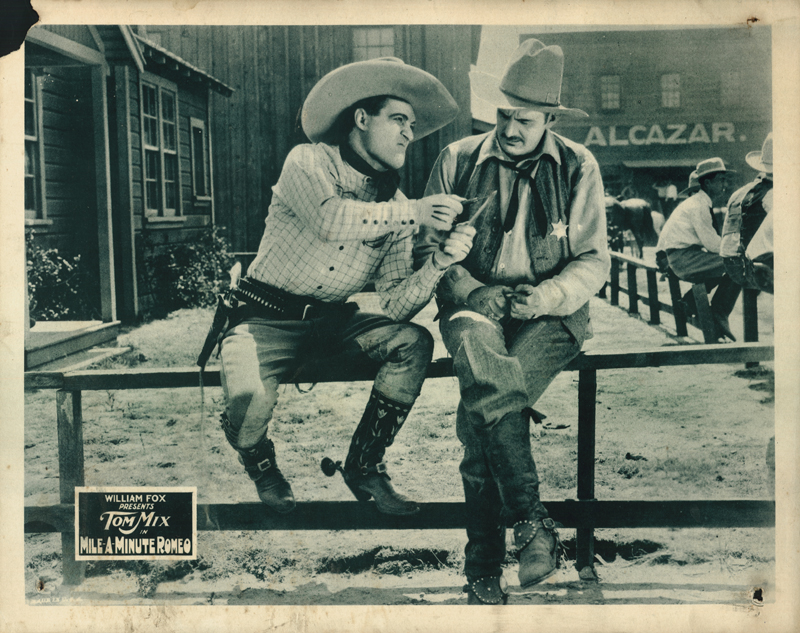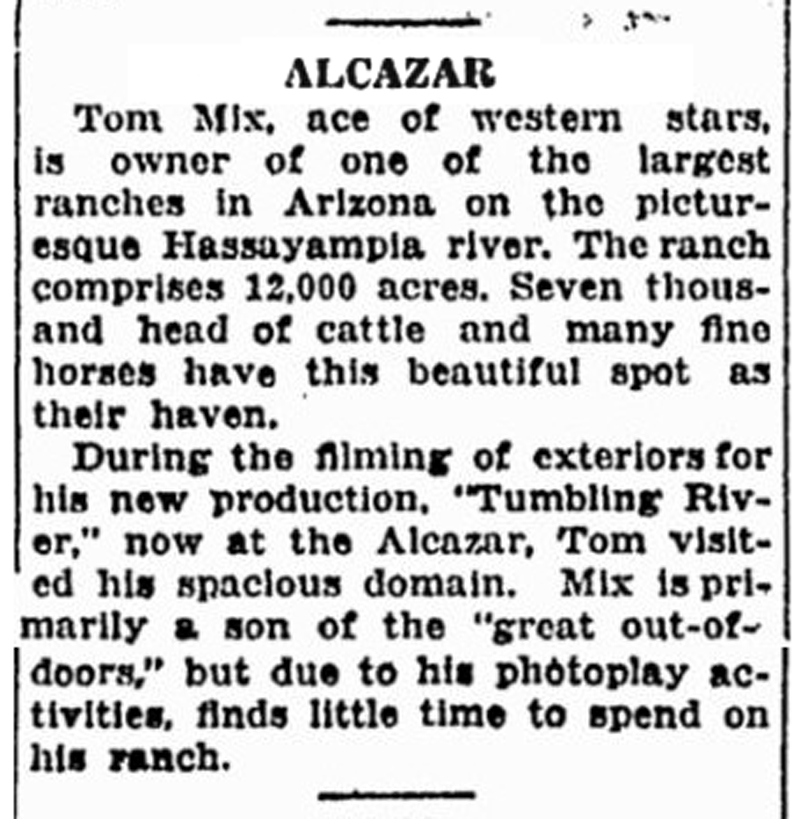|
|
Fox 1923 | Starring Tom Mix

Click image to enlarge Tom Mix stars as Lucky Bill in "Mile-A-Minute Romeo" (Fox Film Corp. 1923). Original blue-toned lobby card, 11x14 inches. According to Mix biographer Robert S. Birchard (1993:180), "Mile-A-Minute Romeo" was shot at various locations in the Los Angeles area. Production started July 24, 1923, and was completed Sept. 1, 1923. The film was released either Oct. 28 or Nov. 18, 1923. We don't know what locations were used; Mix was shooting in the Newhall area and Echo Park and elsewhere at this time. "Mile-A-Minute Romeo" comes on the heels of "Three Jumps Ahead," which was released earlier in 1923 and shot on location in Newhall. Curiously, "Alcazar," seen on the building in the background, was the name of Mix's ranch in Arizona (see below). We don't know if this scene was shot at his ranch, or if he merely used the name at another location. The director is Lambert Hillyer, who also directed several William S. Hart pictures. The scenario (screenplay) is by Robert N. Lee from a story ("The Gun Gentleman") by Max Brand. The cast includes Betty Jewel, J. Gordon Russell, James Mason, Duke Lee, James Quinn and Mix's horse, Tony, which is credited as "Tony the Horse" (and which Mix purchased in Newhall). Birchard (1993:181) notes that in this picture, Mix "performed most of his stunts with cameras close-on so audiences could see that he was doing them himself." Tony, however, was doubled. Description from Motion Picture News Booking Guide No. 6: "Western melodrama presenting the usual assignment of gun fights and thrills in which Tom Mix specialized. Lucky Bill falls in love with a girl betrothed to another. He takes matters into his own hands and the girl in his arms and rides away with her. She is finally won by his heroism and becomes a willing bride." This is one of many "lost" Tom Mix films. Birchard writes (pg. 133):
In 1937, 20th Century-Fox suffered a major vault fire at its East Coast storage facility, and the original negatives for virtually all of the Fox Film Corporation's silents and early talkies were lost. For years, it was thought that only two of Tom's eighty-five Fox pictures survived, "Sky High" (1922) and "Riders of the Purple Sage" (1925). However, in the late '60s, 20th Century-Fox embarked on a search for its early film heritage and a few more Mix titles turned up, including "The Untamed" (1920), "The Night Horsemen" (1921), "Trailin" and "Just Tony" (both 1922), "Soft Boiled" (1923), "The Rainbow Trail" and "Dick Turpin" (both 1925), "The Great K&A Train Robbery" (1926), and "The Last Trail" (1927). Another dozen or so titles turned up in Czechoslovakia, including "The Road Demon" (1921), "Teeth" (1924), "North of Hudson Bay" (1924), "The Best Bad Man" (1925), and "Oh, You Tony!" (1924). Unfortunately, the Czech versions generally survive in beat up exchange prints, with missing footage, and four-frame Czech flash titles, making them virtually incomprehensible. A print of "The Texan" (1920) is known to survive at the Danish Film Archive, and others may yet surface — although time is running out for any fragile nitrate prints that might rest in a forgotten vault, attic or garage as tantalizing fragments of "Hearts and Saddles" (1917) and "Fighting For Gold" (1919) attest.
Alcazar. St. Petersburg (Fla.) Times | April 12, 1928. Tom Mix, ace of western stars, is owner of one of the largest ranches in Arizona on the picturesque Hassayampia [sic; Hassayampa] river. The ranch comprises 12,000 acres. Seven thousand head of cattle and many fine horses have this beautiful spot as their haven. During the filming of exteriors for his new production, "Tumbling River," now at the Alcazar, Tom visited his spacious domain. Mix is primarily a son of the "great out-of-doors," but due to his photoplay activities, finds little time to spend on his ranch.
About Tom Mix. Born in Mix Run, Penn., on Jan. 6, 1880, Tom Mix appeared in more than 300 films (counting "shorts") from 1909 to 1935. He occasionally filmed in Newhall from 1916 to the mid-1920s and set up one of his early "Mixville" Western movie towns between Spruce Street (now called Main Street) and Newhall Avenue. A part-time Newhall resident during that period, Mix lived across the street (probably on Walnut Street) from the Thibaudeau home, which was located at the southwest corner of Market Street and Newhall Avenue. In a televised interview, lifelong Newhall resident Gladys Thibaudeau Laney (1910-2014) said she observed Tom buying his sidekick "wonder horse" Tony on her family's property when she was a young girl. The timing works; Tom reportedly purchased Tony for $600 in 1917 from Pat Chrisman (1882-1953), a horse trainer and actor friend who co-starred in a number of Mix films (Birchard 1993:118). In the late Teens, Mix established his most famous "Mixville" on Glendale Boulevard in the Silver Lake section of Los Angeles. Prior to his movie career, Mix appeared in a series of Wild West shows where he was noticed by pioneering film producer Col. William N. Selig, who hired him to handle horses. He worked with Selig, writing, directing and acting, until 1917, when he signed with Fox to star in moving pictures alongside Tony. Mix reached the height of his popularity during the 1920s, assuming the mantle of King of the Cowboys from William S. Hart, who retired from filming in 1925. But Mix did not adapt well to "talkies," and his career waned in the 1930s. His popularity remained intact, however, as he took his show on the road on the Western performance circuit. It was on the road that he would perish, when his 1937 Cord sent him to an untimely demise on Oct. 12, 1940, south of Florence, Ariz. Adding insult to injury and death, most of the 85 films he made with Fox were lost in a 1937 fire at the company's East Coast storage facility. But Mix was remembered fondly through his radio show and comic books, which outlived him by more than a decade.
LW2772: 19200 dpi jpeg from original lobby card purchased 2015 by Leon Worden. |
Arrives in Newhall, 1916: News Reports
(Tom Mix Mayor??)
Newhall Mixville
Newhall Mixville?
Mix in Newhall: Birchard Story 1971
Tom & Tony 1919
Reckless Driving, Newhall 1920
On Location in Newhall 1922
Studio Cottage
Tom Mix & Tony
The Man Within 1916
Western Blood 1918
Fighting for Gold 1919
Prairie Trails 1920
Clip: Wertz/Placerita House Torched for "Trailin'" 1921
3 Jumps Ahead Lobby Cards x3
3 Jumps Ahead 1923
3 Jumps Ahead 1923
Ads for 3 Jumps Ahead 1923
Mix Says He Jumped Beale's Cut 1923
1923 Letter: 3 Jumps Ahead
Mile-A-Minute Romeo 1923
The Rainbow Trail 1925
Arcade Card
Grauman's Chinese Theatre 12-12-1927
King Cowboy 1928
Pays Back Taxes 1930
Final Ride 1940-1990
No. 1 - Jan 1948
No. 8 - Aug 1948
Modern Portrait
|
The site owner makes no assertions as to ownership of any original copyrights to digitized images. However, these images are intended for Personal or Research use only. Any other kind of use, including but not limited to commercial or scholarly publication in any medium or format, public exhibition, or use online or in a web site, may be subject to additional restrictions including but not limited to the copyrights held by parties other than the site owner. USERS ARE SOLELY RESPONSIBLE for determining the existence of such rights and for obtaining any permissions and/or paying associated fees necessary for the proposed use.






























